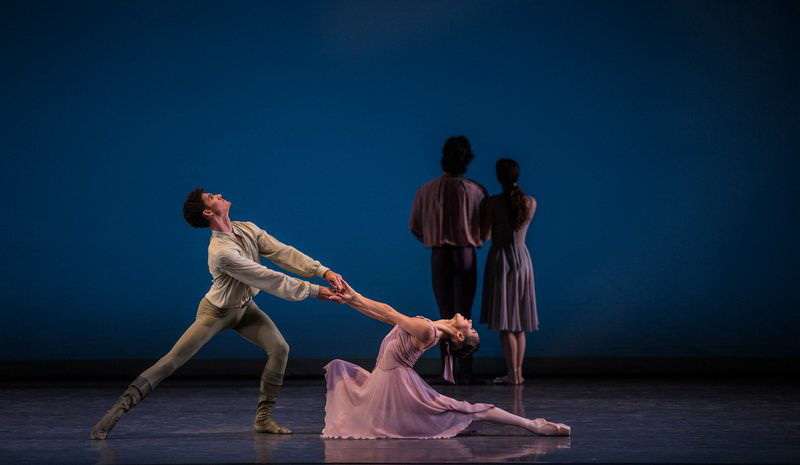|
Back
Lovely... Palm Beach
Kravis Center for the Performing Arts
04/05/2013 - & April 6*, 7, 2013
Jerome Robbins: Dances at a Gathering (music by F. Chopin)
George Balanchine: Slaughter on Tenth Avenue (music by R. Rodgers)
The Miami City Ballet soloists, Nathalia Arja, Sara Esty, Tricia Albertson, Callie Manning, Leigh-Ann Esty, Kleber Rebello, Carlos Miguel Guerra, Jovani Furlan, Michael Sean Breeden, Didier Bramaz, Renan Cerdeiro, Jeanette Delgado, Yann Trividic, Reyneris, Reyes, with corps of the Miami City Ballet
Francisco Rennó (piano), Opus One Orchestra, Gary Sheldon (Conductor)
Jo Mielziner (Scenic Design), Joe Eula, Irene Sharaff (Costume Design), Jennifer Tipton, John Hall (Lighting Design)

(© Daniel Azoulay)
Dances at a Gathering has earned the reputation of being one of the greatest ballets of the second half of the twentieth century. When Miami City Ballet first did it in 2006, the audience response was not especially positive. It is a beautiful work but it has neither the enormous size nor a score that knocks people out. The choreography is proudly and honestly subtle and the score is simply a series of Chopin piano works so that alone explains that one had better not be looking for something the size of a Tchaikovsky or even Stravinsky. Dances at a Gathering might then seem like a sort of “thinking man's” ballet, but it is not; it is simply a large collection of relatively small pieces. When the company did it a couple of seasons later the response was better and with this revival, it seems as if the work is now a company benchmark.
It is often said that with enough exposure, eventually one will be able to see the music and hear the dance. Can that ever be more true than with Dances at a Gathering where, though impossible, it appears as if Robbins inspired Chopin as much as the other way around. The stage pictures are endlessly striking and opportunities for dancers to sparkle seem infinite.
Nathalia Arja once again shows a line that no one else can make look as fluid and easy. Sara Esty's bundle of energy can't help but make one think of a very feminine cowgirl. Callie Manning's solo is startlingly mysterious and the lack of surrender she exhibits after having her overture rejected by three strapping young men is humorous and dignified. The men’s roles in this ballet do not offer the weight that the women are given. Still, Kleber Rebello makes an authoritative and eventually a very moving leader of this gathering. And Carlo Miguel Guerra provides a solid masculine presence that gives the piece its needed balance.
This is what dance is all about. Look too deep and you will miss the point. Dances at a Gathering is a tremendous gift to dance lovers. We are allowed into the dancers' world for just an hour to maybe gain a tiny impression of their purpose. It is silently breathtaking.
Significant history surrounds the program's finale. Slaughter on Tenth Avenue was originally created for a 1930s Rodgers and Hart musical. What we now have is probably still quite faithful to Balanchine's intentions since there were substantial revivals during the lifetimes of those originally involved. Story ballet was never the master's forte and that is what this is. It marks the origin of the American musical's “dream” ballet, a concept that has not been used in decades. In “dream” ballet the story is a reprise of the plot up to that point with a hint at a possible resolution, usually unhappy. Agnes DeMille owed a great debt to Balanchine's Slaughter for fleshing out the strategy, but his result didn't reap the rewards of those who followed him. Gene Kelly's abbreviated version for M-G-M in the 1940s (which can be found on You Tube) has more clarity and spunk.
It is colorful and light (too light), thus a good ending for a program. But the thing that really carries this piece is not the choreography but Richard Rodgers' score. In fairness part of Balanchine's problem might have stemmed from an inadequate libretto for which Rodgers is partly credited. They were experimenting, give them a break; but the finished product could use some rethinking now that almost eighty years have passed. Jeanette Delgado is fine as the Strip Tease Girl but the choreography never uses the sense of doom that is essential to the pas de deux so that she can give some dimension, similarly with the Hoofer of Renan Cerdeiro; though Big Boss is both funny and scary because Yann Trividic is such a clever actor. The role of Morrosine is the most memorable because Reyneris Reyes plays the egotistical danseur without restraint but never goes overboard. The music is as magnificent as always though Opus One Orchestra sounded unusually sloppy under the direction of Gary Sheldon.
This performance will be offered again in Fort Lauderdale at the Brower Center for the Performing Arts from April 26-28, and in Miami at the Adrienne Arsht Center May 3-5.
Jeff Haller
|